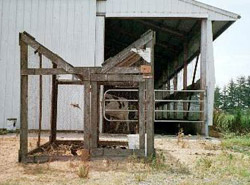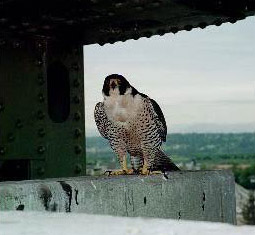A Scourge of Starlings
Air Date: Week of September 12, 2003
Starlings are the birds that bird-lovers love to hate. The non-native birds have ousted native species in just about every state, and they’ve caused damage to farmers’ crops and airplanes in flight. John Ryan takes a look at how one county in Washington state is trying to manage its starling population.
Transcript
CURWOOD: In all of William Shakespeare’s works, the starling is mentioned just once, in the play “Henry IV, Part One.” But that’s all it took to inspire a Shakespeare fan in the 1890’s to release a hundred of these European birds into New York’s Central Park. In a matter of decades, the birds’ shiny black descendants had spread coast to coast, eating crops and killing native birds along the way. Today, farmers, and even some bird lovers, are fighting back against this avian invader. John Ryan reports from Washington state.
[BARN SOUNDS]
RYAN: A few miles south of the Canadian border, Jason Vander Veen raises 700 cows on his farm in Washington’s Whatcom County. It’s one of the top dairy-producing counties in the nation and Vander Veen says starlings are the number one pest for the area’s dairy farmers.
VANDER VEEN: There’s times when there’ll be 3,000 of them flying around. It’ll just be a black cloud in the sky going around. Quite often in the wintertime, it’s usually the worst in the barns, and I wear a hooded sweatshirt just so I don’t get anything down the back of my neck.
RYAN: Vander Veen stands inside a concrete feed bunker big enough for a truck to drive into. Unlike many dairy farmers, Vander Veen covers his bunkers with tarps and tires to keep starlings out. But the aggressive birds still peck away at the mounds of dairy feed wherever they can.
VANDER VEEN: They like our corn. See, they’ll pick all these little kernels out of here, they’ll just go along and just go like that [SOUND OF GRAINS FALLING] and we’re just left with all the fiber to feed our cows.
RYAN: A flock of a thousand starlings can consume up to a ton of feed in a month and contaminate several more tons with their droppings. So farmers like Vander Veen have turned to the U.S. Department of Agriculture for help. With partial funding from the county, the local farmers’ association has hired USDA’s Wildlife Services to trap the birds on the dairy and blueberry farms where they do the most damage.
 Starling trap behind Jason Vander Veen’s dairy barn. (Photo: John Ryan) Starling trap behind Jason Vander Veen’s dairy barn. (Photo: John Ryan) |
[STARLINGS IN CAGE - WING FLUTTERS, CHIRPING]
RYAN: Between Vander Veen’s feed bins and his dairy barn, Wildlife Services has placed a six-foot-tall chicken wire shed with a narrow slot in the roof. VANDER VEEN: So here’s our starling trap. They drop straight down and they can’t fly straight up so they can’t get their wings out to fly back out of it. And then USDA comes and they put them in a five-gallon bucket. And then they gas up the CO2 in to gas them. RYAN: According to Wildlife Services, it’s a quick, humane death. In Whatcom County, the agency kills about 50,000 starlings a year. Nationwide, it kills a million of the birds annually. That’s a lot of birds, but it’s a tiny fraction of the estimated population of more than 200 million European starlings in North America. Henry Bierlink of the Whatcom County Agriculture Preservation Committee administers the local starling-control program. BIERLINK: I don’t think anybody likes killing birds. I think we’re getting over it when it comes to starlings. [BIRDS CHIRPING, WINGS FLAPPING] RYAN: One place you’re not likely to hear starlings is the hundred acres of woods owned by Whatcom County physician and amateur naturalist Patricia Otto. [WOOD DUCK CALL] OTTO: That’s the female wood duck. She’s just right down on the water here. RYAN: Near the edges of her woods, Otto has erected 30 wooden boxes on stilts. They’re nest boxes for wood ducks. Along with 20 other species in Washington state, wood ducks normally nest in tree cavities left behind by woodpeckers. But thanks to a century of logging, big old trees are hard to find, and starlings have invaded many of the tree cavities that remain. OTTO: If a wood duck has laid a couple eggs in there, the starling will just start bringing nest material in - cover up those eggs, keep the wood duck out, and take over. They’re very aggressive. RYAN: Starlings have evicted native birds from their nests in every state except Hawaii. On her property, Otto has trapped starlings in fake nest boxes for the past decade, and she’s seen the number of starlings in her woods steadily decline. She admits she does have mixed feelings about killing birds. OTTO: I love birds, but it’s what I really have to do. In our county, historically, we had bluebirds and purple martins, and neither of those are here anymore since the invasion of starlings and English sparrows. And we could lose other cavity nesters if we don’t try and control our starlings. RYAN: Even bird-loving organizations like the Washington Audubon Society tacitly approve of starling trapping since the starlings are such a threat to native birds. And sometimes, starlings threaten even the biggest birds. [JET LANDING] RYAN: Starling Road runs along the west side of Seattle-Tacoma International Airport. It was named for the huge flocks of starlings that used to plague the airport. Port of Seattle biologist Steve Osmek spends most of his time trying to ensure that birds and airplanes don’t mix. OSMEK: In the late 70s, we were looking at starling numbers of about 100,000. Today, in contrast, we have probably 5,000 birds. It’s the largest flock size that we’ll ever see. RYAN: Last year, a 737 taking off from SeaTac crossed paths with a flock of a thousand starlings. The pilot had to make an emergency landing after 27 of the birds hit the plane and were sucked into the engines. Airport personnel call starlings, with their stubby wings and dense bodies, “feathered bullets.” OSMEK: If they’re ingested into engines they can cause engine failures but, by and large, even if it startles the pilot, that’s not something that anybody wants. RYAN: The airport hires Wildlife Services to trap about 4,000 starlings a year. But Osmek’s main focus is making the airport less inviting as bird habitat in the first place. OSMEK: With the landscaping plan that we have today, we’re selecting trees that are less attractive. They don’t provide the fruits, nuts, and berries that some other trees may and may attract starlings, red-winged blackbirds, and other birds that could be hazardous to airport operations. RYAN: When starlings do congregate near the runways, Osmek is forced to get out the heavy artillery. [METALLIC CLICK - HIGH PITCHED WHIZZING SOUND, REPEATED] RYAN: The airport uses a half-dozen different noisemakers, even recordings of starling distress calls. Osmek says the birds learn quickly to ignore particular noises, so variety is necessary to keep them guessing. [POPPING SOUNDS] RYAN: But these widely despised European birds do have fans in high places. [BIRDS CALLING, BOOTS CLANKING ON METAL STAIRCASE, HIGHWAY TRAFFIC]  Starling fan: peregrine falcon on a Seattle-area bridge. (Photo: John Ryan) Starling fan: peregrine falcon on a Seattle-area bridge. (Photo: John Ryan)
[FALCON CALLING] ANDERSON: For years I thought starling were just vermin, but over the years I’ve really grown to appreciate them. They have a unique beauty. They’re just cool birds really. [FALCON CHICKS SHRIEK] RYAN: Once inside the nest, Anderson tags and takes blood samples from two newborn falcon chicks. He studies their diet from bones and feathers he finds lying around. The shrieking parents fly angry loops around the nest. ANDERSON: She’s got a full crop. That means the mom has already fed her. You can see right here - this is probably starling right there. These are very well fed young peregrines. RYAN: Anderson says starlings aren’t bad for all native birds. They provide a lot of the protein that’s helping peregrine falcons recover from near-extinction. ANDERSON: Peregrines are noted for taking all kinds of bird species, but around here in the 30 pair or so we’re looking at in northwestern Washington, the prey items are mostly composed of starling, pigeon, robin, and cedar waxwing. But starlings is the number one. We find them in, literally, in every nest we go into is starlings, starlings, starlings. [FALCON SHRIEKS] RYAN: Like most biologists, Anderson believes there’s little hope of reducing starling populations on a large scale. But farmers, bird lovers, and even peregrine falcons continue to do what they can to take a bite out of America’s giant flocks of European starlings. For Living on Earth, I’m John Ryan in Seattle. Living on Earth wants to hear from you!Living on Earth Newsletter [Click here]
Donate to Living on Earth! NewsletterLiving on Earth offers a weekly delivery of the show's rundown to your mailbox. Sign up for our newsletter today!
|





